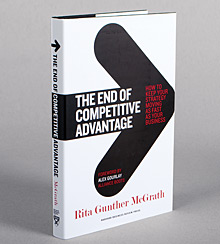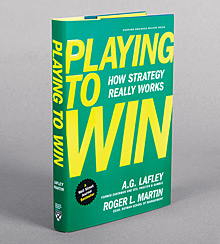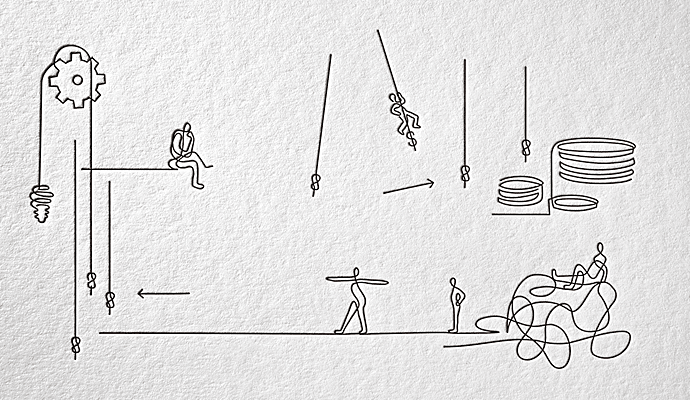Best Business Books 2013: Strategy
Rebuilding the Temple Mount
(originally published by Booz & Company)
Rita Gunther McGrath
The End of Competitive Advantage: How to Keep Your Strategy Moving as Fast as Your Business
(Harvard Business Review Press, 2013)
A.G. Lafley and Roger L. Martin
Playing to Win: How Strategy Really Works
(Harvard Business Review Press, 2013)
Nassim Nicholas Taleb
Antifragile: Things That Gain from Disorder
(Random House, 2012)
The temple mount of Great Management Ideas hasn’t much changed recently. The marble-columned edifice devoted to Business Strategy still stands in magisterial splendor, its priests silver-haired and slightly smug, if a little paunchy. Nearby, in the more modern Temple of Innovation, adorned with black glass, high-tech types in T-shirts attract a younger, livelier crowd. Across the way, in the rainbow-colored tents of the Sanctuary of Leadership, ex-CEOs emote, while in the more shadowy nooks, dreadlocked fakirs spout their wisdom, accompanied by the scratching of nearby chickens.
A reading of this year’s best business books on strategy suggests it’s time to bring in the wrecking ball and thoroughly rearrange the real estate.
Since its invention in the 1960s, modern corporate strategy has been about change. What company ever went looking for a new direction because its current course was proceeding swimmingly? The fresh insight this year, after more than a decade of emergence, is that nowadays strategy is change. Almost any competitive advantage is fleeting and you must constantly be managing your company with an eye toward innovation in not just your market offerings, but also your business portfolio and business models. Strategic leadership has come to consist largely of the continuous and deliberate navigation of change.
Transient Advantage
In The End of Competitive Advantage: How to Keep Your Strategy Moving as Fast as Your Business, Rita Gunther McGrath provides much useful advice on the how of managing business strategy as continuous innovation but shorts her audience just a bit on the why. Not that most readers will miss the statistics, available elsewhere, on how quickly industry leadership turns over today compared to, say, three decades ago.
To be sure, skeptics will look at the rise of behemoths such as Apple, Amazon, Google, and Walmart and see a consolidation of corporate power and apparently unassailable competitive advantage. But for every skeptic, there are 10 or 20 warriors in the corporate trenches who believe their companies are under assault as never before and feel an unprecedented amount of change being thrust upon them. At least that would be my guess from talking to scores of executives.
For her evidentiary base, McGrath, a professor at Columbia Business School, and her research team scanned a list of every publicly traded company on any global exchange with a market capitalization of US$1 billion or more by the end of 2009. Looking for what she came to call “growth outliers,” she was able to identify precisely 10 companies that were able to grow their net income 5 percent annually from 2000 to 2009. A few of the names on the list are familiar (such as Cognizant Technology Solutions, Infosys, Yahoo Japan, and Tsingtao Brewery), whereas others are less so (such as Krka d.d. Novo Mesto, a pharmaceutical company from Slovenia).
In delving deeper into these enterprises, McGrath uncovered an intriguing combination of stability—involving identity, culture, and people development—and change. Each company’s identity served as a platform for a continuous reconfiguration of its portfolio of businesses and its activities within those boundaries. Her outliers are prepared to reorganize themselves repeatedly in order to systematically catch waves of competitive advantage that rise up quickly, peak, and then recede.
The outliers will, according to McGrath’s five-stage rubric, launch a small effort if they see an aborning market opportunity, then ramp up quickly if it proves out and they can capture territory. They’ll exploit the business as long as it’s robustly profitable, all the while looking for the first hints of decline, such as new competitors piling in or commoditization. Spotting trouble, they will see if they can reconfigure the business model to prolong returns, but if that doesn’t work, they’ll crisply disengage—exiting the business and deploying their resources elsewhere.
McGrath and her corporate champions recognize that the different stages of this business life cycle may require managers with different skills. The outliers provide for that in their approaches to training and staffing. One is reminded of the old saying that over the course of its lifetime a business needs first a risk taker, then a caretaker, and finally an undertaker.
The End of Competitive Advantage gets particular punch from the author’s comparison of her outliers’ modus operandi with how traditional organizations approach the problem of disappearing competitive advantage. The contrast also suggests the wrenching change required of old-line outfits if they want to compete in this new world of transient competitive advantage, and illustrates what a feat of leadership it is to work that change.
In the conventional company, resources—that is, capital and people—are held tightly in the hands of the business unit heads, who try to squeeze opportunities into the existing structure. In effect, they emphasize the exploitation phase (“keep doing what we’ve been doing”) and innovate only in fits and starts. Competitive advantages are defended to the bitter end, but when that comes (usually too late to find other alternatives for the business), the conclusion is unexpected, harsh (big-time downsizing), and liable to leave a bad taste in everyone’s mouth.
In the growth outliers, by comparison, everybody understands that investment capital is the property of the company as a whole, to be doled out by the corporate center as new opportunities present themselves. In this world, a unit’s leaders may even volunteer that it has more money than it needs and cheerfully remit the excess to headquarters. Employees understand the business unit “circle of life” (apologies to Disney) and know that they’re expected as part of their everyday jobs to be searching relentlessly for innovations, fresh market openings, and threats to the old. The smartest outfits not only instill this ethic, but also cushion potential dislocations by finding new places for those employees whose units have experienced “healthy disengagement” from their former parent.
Unless what McGrath calls continuous reconfiguration was installed with their genes, most organizations don’t seem to take easily to innovation. Building on her earlier book with Ian C. Macmillan, Discovery-Driven Growth: A Breakthrough Process to Reduce Risk and Seize Opportunity (Harvard Business School Press, 2009), McGrath lays out a process for building this capacity into an organization. Many of its elements have been written about elsewhere: formal governance and funding models; experimentation; senior management involvement; a portfolio of new initiatives; an options-based investment approach; and an ability to accept and learn from intelligent failures. Familiar perhaps, but no small leadership challenge to put in place.
Three or four qualities distinguish the mind-set of company leaders who face up to the reality of transient competitive advantage, and those qualities are useful even at companies that don’t approach the McGrathian ideal. One theme I hear a lot of lately from smart strategic thinkers is the absolute imperative to create a flow of information from the corporate periphery—from reps actually talking to customers and factory managers listening to suppliers and wild freelance types attending offbeat conferences—to the central, strategy-making intelligence of the enterprise.
The leaders of McGrath’s paragons do this as a matter of course, seeking inputs from a diverse set of resources and trying to widen the constituencies engaged in making strategy. They particularly seek “disconfirming” information, tidings that suggest the enterprise’s current understanding of the outside world is flawed or incomplete—signals of trouble. (In contrast, say, to the Wicked Witch running a sweatshop in the movie version of The Wiz, with her managerial mantra, all too common in the real world: “Don’t nobody bring me no bad news.”)
The leaders of McGrath’s outliers also prefer to be fast and roughly right versus slow and precisely right, taking up an option rather than engaging in an endless analysis of anticipated net present value. And contributing to the culture they want to create, outlier leaders hire not so much for existing or demonstrated skills as for what Kris Gopalakrishnan, cofounder of Infosys, calls learnability—the capacity to acquire new skills. Like the ones that will be required in that new business just over the next hill.
Five Strategic Injunctions
At first blush, Playing to Win: How Strategy Really Works, by A.G. Lafley and Roger L. Martin, seems at odds with McGrath’s focus on the transience of competitive advantage. If you read only Lafley and Martin’s prescribed steps for making business strategy, you might think you’ve been presented with a semi-classic framework, albeit one tempered by years of practical experience. Lafley was the highly successful CEO of Procter & Gamble from 2000 to 2009, helping the company double its sales and quadruple its profits (so successful, in fact, that he was recently called back to his old job when his successor floundered). Martin was his longtime strategy consultant at Monitor Company, before going on to become dean of the University of Toronto’s Rotman School of Management.
Lafley and Martin invoke Michael Porter’s five forces model for gauging industry attractiveness, a model long criticized for its allegedly static quality. (Forget “industry” anyway, argues McGrath, concentrate instead on “arena.”) They ritually tug their respective forelocks to the received wisdom that any competitive advantage you devise must be sustainable.
It’s only when you dig down into the book’s many detailed examples, drawn from P&G’s experience, that its affinity with The End of Competitive Advantage becomes clear. Almost every case is a tale of a brand gone flat or under attack that must be reinvented, including Oil of Olay (derided by critics as “Oil of Old Lady”), Bounty paper towels (by the late 1990s, the “business was struggling”), and, of course, the redoubtable Pampers. (Ah, where would the study of strategy be without the rich lessons of the diaper wars? See, for example, Michael Porter’s terrific HBS case study, “The Disposable Diaper Industry in 1974.”)
Viewed from this perspective, as a set of cases illuminating the strategy of renewal, Playing to Win belongs right alongside The End of Competitive Advantage and, in fact, may be more useful on how to shake up a company long set in its ways. The real-world examples also provide bite and clarity to Lafley and Martin’s five overall injunctions, which on their own can seem a bit windy, bordering on the banal.
For example, the first, “Define your winning aspiration,” seems less like the ol’ squishy vision statement when it’s sharpened to focus on what you’re going to do for customers—the proper focus rather than products—that others have not done. Rebranded simply as “Olay,” reformulated, and repackaged, P&G’s skin-care product found a nifty niche for itself at an $18.99 price point—the “Oil of” version had sold for $8 or less—able to attract both the “mass shopper” who thought that at that price it must really be something special and the “prestige shopper” who found it a bargain compared to competing products from Clinique and Estée Lauder.
The second injunction, choosing where to play, echoes McGrath’s call for relentless empiricism in looking for arenas where you want to compete—geographies, industry segments, customers. Lafley and Martin include the bracing thought that you shouldn’t view your company’s existing choices as immutable. Deciding how to win, the third injunction, also presents the chance to create new choices where none currently exist. Indeed, if you can’t find a fresh approach, you may want to seek another arena or get out of the game entirely.
The final two injunctions, determining what capabilities you’re going to need to execute your strategy and what management systems are needed to support your choices, can look a lot like building a corporate capacity for continuing innovation. It’s telling that in his credits to outside advisors, Lafley mentions that he used Innosight, a consulting firm specializing in systematizing innovation, at the same time that he used Monitor and Martin for counsel on strategy.
Useful Paranoia
In my career, I’ve had the opportunity to help organizations with hiring. One lesson, acquired at some personal cost, is this: When references report that the candidate “doesn’t suffer fools gladly,” pedal backward furiously. The phrase is typically code for: “However talented, he or she is an ass—narcissistic, oblivious to the sensibilities of others, and, in the end, likely to explode any equanimity your team might possess.”
Upon a superficial reading of his newest book, Antifragile: Things That Gain from Disorder, one might conclude that Nassim Nicholas Taleb doesn’t suffer fools gladly. In fact, he’d probably be the first to tell you so—and he does, repeatedly. Taleb has no use for consultants, almost all economists, academics, large corporations, large banks, the typical central government, the “Soviet–Harvard” establishment (whose members believe, he says, that their lectures on how to fly enable birds to do so), Nobel Prizes and prize winners, and most forms of routinized planning.
Why then include Taleb’s book among the year’s best works on strategy? For at least three reasons. First, it’s a slap-upside-the-head antidote to any potential hubris on the part of a strategic planner or, for that matter, anyone else who thinks he or she can confidently predict what’s going to happen. (Those smug, silver-haired priests?) As in his prior works Fooled by Randomness: The Hidden Role of Chance in the Markets and in Life (Texere, 2001) and The Black Swan: The Impact of the Highly Improbable (Random House, 2007), Taleb brings home just how vulnerable we are to the unexpected.
Second, from Taleb’s wild, seemingly otherworldly perspective comes a lot of support for the relentlessly experimental, small-scale-at-first, buy-options-when-you-can strategy building that McGrath advocates. Taleb classifies phenomena according to their place in a “triad” of vulnerability: from the fragile (a porcelain teacup; the incredibly intertangled global banking system), through the robust (things that can take a few hits, such as owner-operated businesses), to the antifragile, which actually benefit from a few knocks (the human body, if the blows aren’t too heavy; a writer’s work as it’s exposed to criticism).
For a strategist looking to develop an antifragile business, the point would be not to sit there with industry analyses and economic forecasts—almost inevitably incorrect or irrelevant, according to Taleb. Instead, a strategist should go looking for the opportunities hidden in the knocks and bumps presented by the on-the-ground realities of ever-changing markets. He tells the secondhand but hilarious tale of an acute student of market movements who did very well for years trading in “green lumber,” all the while thinking he was dealing in boards painted green rather than in freshly harvested timber.
For more than a decade, scholars have been advocating and explaining the use of real options in strategy—valuable work, but pretty tough going for the average strategist. Given Taleb’s sense of ever-looming uncertainty, his discussion of options and the necessity of acquiring them can be downright thrilling. His analysis traces their use back to the pre-Socratic philosopher Thales, and he buttresses his advocacy with arguments from classic Stoic philosophers, particularly Seneca.
Anyone who sends us back to read Seneca can’t be all bad. (What other book have you encountered recently that left you wondering, “Gee, I wonder what the author would have had to say about Diogenes?”) And therein lies the third reason for recommending Antifragile. Although maddeningly opinionated, at least a third too long, and freighted with 70 pages of relatively unreadable appendices and bibliography, the book is full of refreshing, in-your-face challenges to what we think we know, put-downs of the otherwise celebrated (Glenn Hubbard, Joseph Stiglitz, and Tom Friedman, to name just a few), and practical insights useful even in daily life. Taleb notes, for example, that most of the foods he enjoys—wine, cheese, some fruits, vegetables, meat, and fish—have been around a long time, and that nowadays all the most delicious varieties seem to come from small producers, not large industrial enterprises. Perhaps not a shockingly original observation, but useful to ask your waiter about the next time you’re contemplating a menu.
Toward the end of Antifragile, there’s a lovely confessional passage about how Taleb temporarily lost his soul when he suddenly became a famous author, permitted himself to be courted by journalists, and went around trying to explain his ideas to audiences who had little interest in trying to understand them. He found his way back to sanity by returning to his prior routine of spending most days reading and writing. Maybe the biggest surprise of all in the book is that despite the author’s best efforts to persuade you to the contrary, by the time you’re through reading, you almost kind of like the guy.
What might the redesigned Temple Mount of Great Management Ideas look like? Perhaps its central feature should be a multi-faced, possibly rotating edifice dedicated to the proposition that “business strategy is change as led by relentless innovators” and linking the systemic elements called out by McGrath, the author of the year’s best business book on strategy. It could have a few pillars, classical-strategy style, courtesy of Lafley and Martin. And on its roof, driven by gusts of useful paranoia from Taleb, wind turbines would continually turn.![]()
Author profile:
- Walter Kiechel III has served as the managing editor of Fortune and the editorial director of Harvard Business Publishing. His most recent book is The Lords of Strategy: The Secret Intellectual History of the New Corporate World (Harvard Business Press, 2010).





